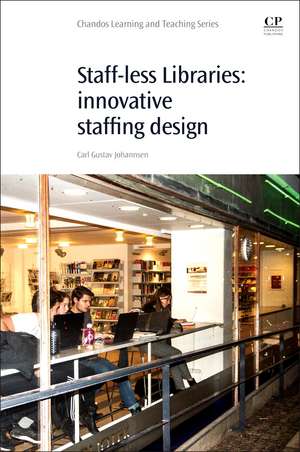Staff-Less Libraries: Innovative Staff Design
Autor Carl Gustav Johannsenen Limba Engleză Paperback – 6 mar 2017
Staff-less public libraries, enabled by technological developments, represent a significant and innovative aspect of the development of public libraries. The concept radically enlarges the availability of user access to public libraries. Some Danish public library branches have, for example, increased their weekly opening hours from 20 to 80 hours per week. In Denmark, the concept has been quite successful, increasing the number of staff-less libraries from 81 public library units in 2011 to 260 in 2014.
From a longer view, however, the staff-less library concept contributes to the modernization of public libraries by further opening the library. Many library professionals have been surprised by the near absence of vandalism through the staffl-ess opening hours. According to the latest trend, the staffless library model is gradually moving from thinly populated rural areas and suburban neighborhoods to urban contexts. This book explores the concept, hence furthering the debate.
- Presents and considers the idea of staff-less libraries using evidence-based data
- Considers the challenges, pros, and cons of the staff-less library
- Identifies international experiences, best practices, and draws out a step-by-step approach to implementation
Preț: 331.31 lei
Preț vechi: 427.37 lei
-22% Nou
Puncte Express: 497
Preț estimativ în valută:
63.40€ • 65.95$ • 52.34£
63.40€ • 65.95$ • 52.34£
Carte tipărită la comandă
Livrare economică 05-19 aprilie
Preluare comenzi: 021 569.72.76
Specificații
ISBN-13: 9780081019238
ISBN-10: 0081019238
Pagini: 190
Dimensiuni: 152 x 229 x 16 mm
Greutate: 0.32 kg
Editura: ELSEVIER SCIENCE
ISBN-10: 0081019238
Pagini: 190
Dimensiuni: 152 x 229 x 16 mm
Greutate: 0.32 kg
Editura: ELSEVIER SCIENCE
Public țintă
Academic librarians, information professionals, public librarians and library administrators, university management and administrators, graduates and researchers in library and information science.Cuprins
1. Introduction
2. Open Library Service in a Broader Perspective
3. The Development and History of Open Libraries
4. Open Library Communities, Users, and Usage
5. Critical Success Factors
6. A Step-by-Step Approach to Implementation
7. Conclusions
2. Open Library Service in a Broader Perspective
3. The Development and History of Open Libraries
4. Open Library Communities, Users, and Usage
5. Critical Success Factors
6. A Step-by-Step Approach to Implementation
7. Conclusions






